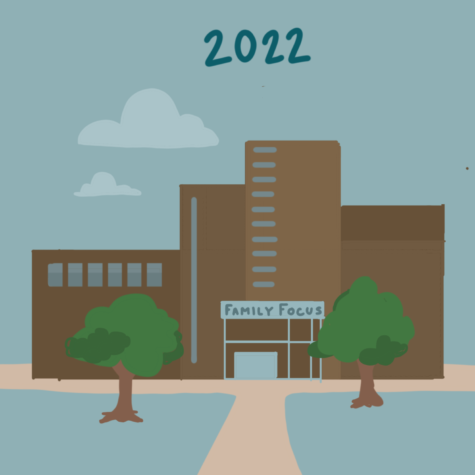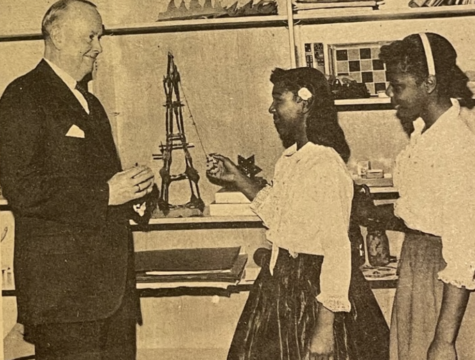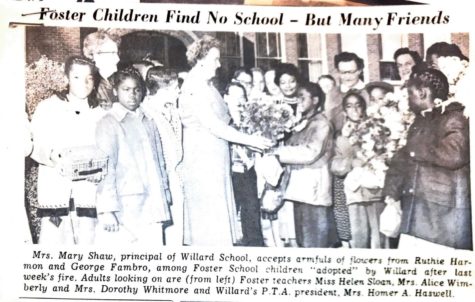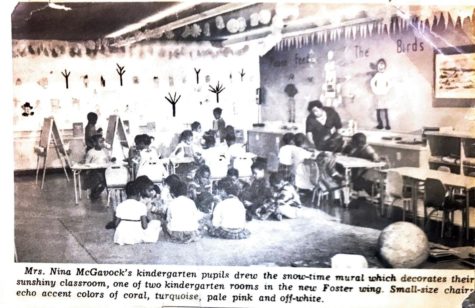Your donation will support the student journalists of the Evanstonian. We are planning a big trip to the Journalism Educators Association conference in Nashville in November 2025, and any support will go towards making that trip a reality. Contributions will appear as a charge from SNOSite. Donations are NOT tax-deductible.
‘Foster School was a pillar’: honoring the legacy of Foster School
January 28, 2022
Closely following the closure of Foster School and the move of Martin Luther King Jr. Laboratory School into the Second Ward, families throughout Evanston had different reactions to the educational changes.
“I do not question that every one of you on the Board have acted professionally, sincerely and out of deep concern for the educational systems of District 65,” Klaus Mueller wrote in a letter to the school board in 1979.

Even with the support from some families, others were hesitant to applaud the board, more focused on the difficult changes that their students would be facing in the coming years as other schools around Evanston closed. Some parents from Kingsley and Foster filed a lawsuit in 1979 against District 65, claiming that the closure of Foster School constituted as racial segregation.
The closure of Foster School left an empty building in the Fifth Ward, also leaving behind a major community focal point.
In July 1979, the Evanston Review published an article explaining how the Foster School’s ad hoc committee created a questionnaire, which was mailed to 2,000 Foster School community residents, seeking ideas for use of the Foster School building. These ideas stretched from creating a trade school for skills like carpentry, plumbing or mechanics to a high school diploma center, an alternative elementary program center to a recreation center and even a roller skating rink or west branch of the Evanston Public Library.
While ideas for what to do with the space were numerous, for over a decade, the former school building stood empty until Family Focus Evanston bought the building in 1987.
“Foster School was a pillar in the Black community. It was the only school that the people in the Fifth Ward went to. It was very important to the parents and the teachers,” Cromer says.
When Family Focus officially bought the former school building in 1987 from D65 after first moving to the Fifth Ward in 1983, the community organization began to transform the space into one that would serve Evanston residents and connect citizens in the Fifth Ward. Prior to its closure, Foster School served as the neighborhood attendance school for residents of the Fifth Ward, connecting students, parents, guardians and teachers. The school had created a space for community building in addition to education, a space that disappeared from the heart of the Fifth Ward after its closure.
“The transformation of the shuttered school building into a vibrant community center serving Evanston’s youth was a testament to ‘what can happen when people in the community pull together,” Bernice Weissbourd, former president of Family Focus, said in a 1987 edition of the Evanston Review.
The purchasing of the former school building by Family Focus began to rebuild community connections in the Fifth Ward. The nonprofit organization was started to support child development and other social services. After taking up residence in the Fifth Ward, Family Focus initiated programming to provide after-school care, family advocacy and other services to Evanston residents.
While the organization has called the Fifth Ward home for over 40 years, Family Focus decided to begin the process of selling the building in 2017. Throughout the process, the directors of Family Focus made it clear that the organization was not leaving Evanston; rather they were only moving to a new location and would continue to provide services to Evanston residents. However, the announcement of this move sparked controversy among residents, many of whom had acclimated to the presence of Family Focus in their neighborhood and were upset by its decision to relocate.

Library
An article published in the Daily Northwestern in 2019, titled “Up for sale, Family Focus commits to maintaining presence in Evanston,” highlighted the various concerns of Fifth Ward residents over the intended move. Many of these worries were centered around the loss of another community center, mirroring some concerns brought up by the closure of Foster School.
Throughout the process of trying to sell the building, residents of the Fifth Ward and other community members advocated for the building to remain within the community. Their advocacy led to the formation of a group called Foster Center Our Place, an organization that would fill the community center role in the Fifth Ward that Family Focus was leaving behind.
After a drawn-out search, Family Focus decided to remain in the former school building, a positive choice which helped to ease some of the concerns voiced by residents. Rather than taking over, the people who created Foster Center Our Place volunteered to help maintain the services and outreach that Family Focus provides, continuing to branch out into the Evanston and Fifth Ward communities. The joint effort from both community organizations led to a renaming of Family Focus, now called Family Focus-Our Place.
Throughout the years since the closure of Foster School, proposals have been brought to the District 65 school board for the creation of a new Fifth Ward elementary school.
The creation of a Fifth Ward school would enable students who live in the Fifth Ward to have a neighborhood school that they can walk to rather than having to be bussed to another elementary school, which has been the case for Fifth Ward students since 1967.
The push for this Fifth Ward school has been a major topic of discussion in Evanston for years. Over the years, there have been numerous attempts to build a neighborhood school in the Fifth Ward to replace Foster School, which at a school board meeting in 2011 came close to being passed. Two of the voting members voted against its creation, effectively silencing the proposal.
“Experience across the country does show that it’s going to be a difficult task to ensure success for all of these kids. Our administration shows annually that we have made good progress on academic achievement, both improving performance of kids and narrowing the achievement gap between white children and our Latino and African American children,” Richard Rykhus, a former District 65 School Board member, explained in an article from the Evanston RoundTable.
Ultimately, Rykhus voted to align with the effort to close the opportunity gap instead of the risk that would come with opening a new school.
“Could Evanston rise to the challenge to ensure success at the new school? It is certainly possible. For me, given the improvements we have seen in academic performance and the factors that I have described, it’s not a risk I’m willing to take,” Rykhus elaborated.
The most recent proposal for a school occured in 2012 when there was a referendum on the ballot aimed at putting $45 million towards building a Fifth Ward school. Based on planning that District 65’s New School Referendum Committee Meeting had done heading into the 2012 referendum, the plan was for students to be pulled out of the Orrington, Kingsley, Lincolnwood, Willard and Dewey catchments.
“Advocates of the new school envisioned a community hub in the Fifth Ward, where students could walk to school and parents could be more involved in their children’s education. Some said it would finally right a wrong caused in the late 1960s when African-Americans in the ward were bused to schools elsewhere in the name of integration,” read a 2012 Chicago Tribune article.
While many Evanston families were in favor of the referendum, 54 percent of Evanston voters ended up voting against it, causing the push to open a Fifth Ward school to fail yet again.
Robinson argued that the very people that provided the diversity would be the ones hurt by the failure of the proposal.
“[But] those same families who [provided diversity] to those schools had been disenfranchised, or their voices always have been muted. So this was an opportunity to do something when there was a benefit to a community, and the amount of money to produce that school would be much more affordable than what it is now,” Robinson says.

In the aftermath of the failed proposal in 2012, Evanston residents and advocates for a Fifth Ward school began to conceptualize different ways to achieve their goal of centralizing access to education for students who live in the Fifth Ward. Through these discussions, a proposal to create a STEM school was raised.
The idea behind the STEM school proposal came following a school board discussion to convert Bessie Rhodes into a Spanish-English immersion school. One of the parents who spoke in opposition of this decision proposed creating a magnet school located in the Fifth Ward instead.
In the proposal to the school board, the STEM school was framed as an open enrollment opportunity, although preference would be given to students who live in the Fifth Ward in an attempt to provide those students with closer access to a school.
As the idea for a STEM school garnered more awareness, parents and interested parties began to collect emails of other interested people. Part of their work included conducting a study with Northwestern University to gauge interest about the creation of the school.
“That study was intended to hear from Black Evanstonians across the whole city, not just the Fifth Ward,” Henry Wilkins, a STEM school advocate, says. “It’s not just about returning a school to the Fifth Ward, it’s about [asking], ‘What are some of the things that the Black community is saying about education?’”
The study done by Northwestern was the result of a grant awarded to a group to survey and amplify Black voices in Evanston in an attempt to fully capture the different perspectives on education.
Proponents of the STEM school argue that although the school’s attendance would be choice-based, allowing students from every part of Evanston to attend, priority would be given to students in the Fifth Ward. This idea fits with the fight to bring back a school to fill the gap that Foster School’s closure left.
“There’s a lot of people that say they want a school to return [to the Fifth Ward]. But there’s a faction of folks that don’t want to see a school return because they’re concerned about gentrification and their taxes going up,” Wilkins explained. “The reason why we think a magnet model makes the most sense is you can prioritize folks that live in the Fifth Ward and make sure that every person that wants to go to this school is guaranteed a seat. And then, make it open to all of Evanston.”
The proposal for a STEM school in the Fifth Ward has not yet been passed by the school board. However, the support from residents and parents has not wavered.
“I think our vision is a winning vision that brings people together. We were very intentional with how we navigate our messaging and our vision to make it more encompassing,” Wilkins explains.
The push to open a Fifth Ward school has cultivated many opinions. While a vast majority of the Evanston community believes the push to open the STEM school is a good idea, others have their concerns about opening the school—increased property taxes being one, with the optics of diversity being the more covert concern underneath.
“Money would be put on the forefront as the reason why,” District 65 superintendent Devon Horton says. “But if you get behind the dollar sign, there are other issues. There are individuals who feel diversity is what makes Evanston great. But I would challenge many and say it’s not the diversity that makes it great alone. It’s the belonging. Students feeling like they belong and being connected is what could make this city even greater.”
White people who voted against the school proposal ignored the positive intentions and impacts of having a Fifth Ward school for the Black community.
“I think people can’t stomach the thought of: here is a brand new school, state of the art school, where the student body is predominantly Black,” Robinson says.
Those defending the Fifth Ward’s legacy are continuing to make improvements to the plan that would call for a well-rounded and diverse school.
Alongside the advocacy to create a new school in the Fifth Ward, efforts have been made throughout departments of the city to honor the historic school. In 2018, a panel of citizens began the process of reviewing the building for a historical landmark designation.
Throughout the tedious process, citizens have advocated in support of the former school building, citing the immeasurable impact the school and Family Focus have had on Evanston and the Fifth Ward community.

Library
Recently, former Fifth Ward alderwoman Robin Rue Simmons spoke in favor of the historical designation in an article published in Evanston Now, explaining the impact that Foster School and Family Focus had on her relationship with the Fifth Ward as a child.
“[The building has been] a resource and place of refuge and empowerment and encouragement in the community,” Simmons said.
In addition to the efforts on the part of the city to preserve the memory of Foster School, other residents have stepped in to highlight the importance of the former school and how it shaped education in Evanston.
In an effort to remember Foster School and honor its legacy, a play entitled “Concerning Foster” was created by Mudlark Theater in January 2020. The play follows Foster School students through the process of desegregating Evanston schools, as well as through the Foster School fire and even into present-day diversity, equity and inclusion conversations happening in Evanston schools.
“We landed on wanting to praise Foster for what it was but also acknowledge the inherent problems that come in having an underfunded, segregated school. [We wanted to celebrate] the fact that it was a place where young Black kids could be around people that look like them, and how, when that’s taken away from you, it really does affect your sense of self,” Kenya Ann Hall, one of the playwrights of “Concerning Foster,” says.
The show served as a look into the influence that Foster School had on its students and future students in Evanston.
“We wanted to show the arc, because oftentimes, when we think of school segregation, we think of it as so long ago, when it’s really not,” Hall says.
“People are alive who went to that school as children. We definitely wanted to highlight Foster [School] as it was, because a lot of people don’t remember it, and the people deserve to see it as a functioning educational institution.”
